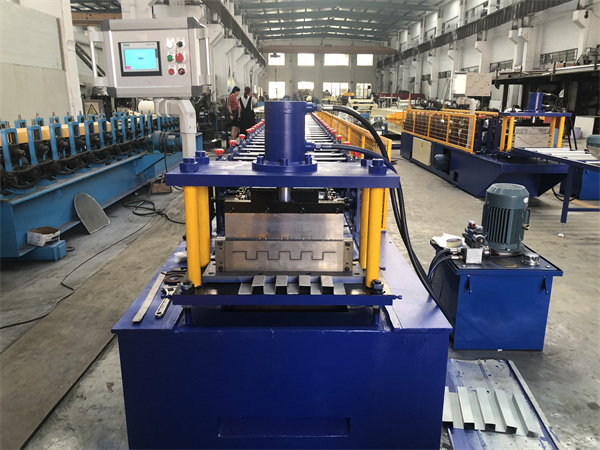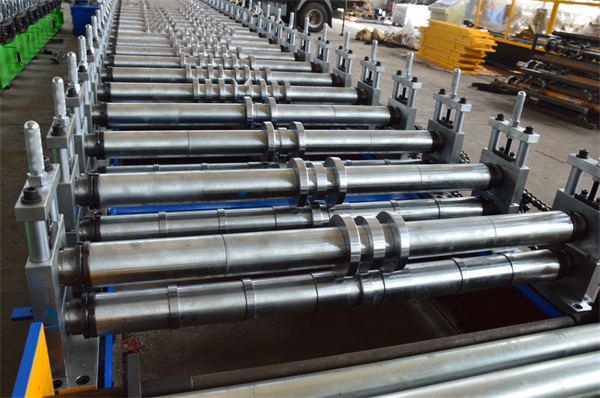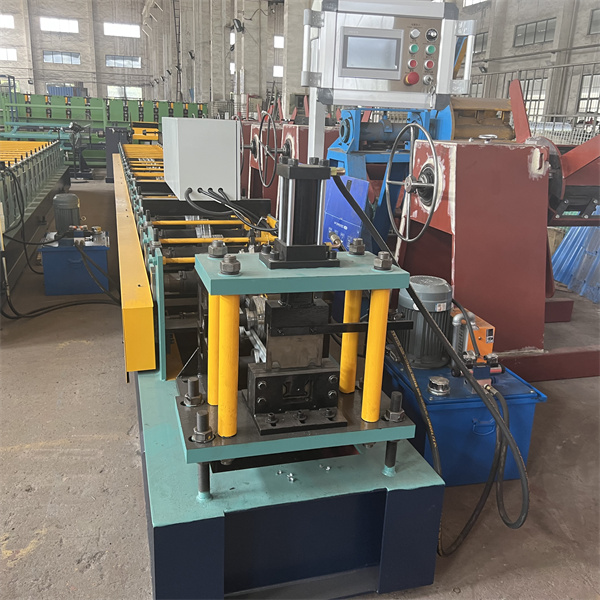Standing seam roll forming machines are an essential equipment for roofing and cladding applications. This comprehensive guide provides a detailed overview of standing seam roll forming machine types, characteristics, applications, specifications, suppliers, installation, operation, maintenance, and more.
Overview of Standing Seam Roll Forming Machines
Standing seam roll forming machines, also known as roof panel roll formers, are machines used to produce standing seam metal roof and wall panels. They transform flat metal coil stock into panels with raised vertical seams.
The roll forming process involves gradually bending the sheet metal into the desired panel profile through a series of roller dies as it passes through the machine. The forming rollers apply pressure progressively to avoid overstressing the material.
Standing seam roof panels interlock together through their raised vertical seams to create a watertight metal roofing system. They are also designed to allow expansion and contraction with temperature changes.
Some key benefits of standing seam metal roofing produced by these machines include:
- Long lifespan with minimal maintenance
- Resistance to fire, impacts, corrosion, leaks
- Ability to withstand high winds and heavy snow loads
- Excellent drainage and ventilation
- Sleek, modern aesthetics
- Customizability of colors, shapes, and sizes
Below are the main types, applications, and specifications of standing seam roll formers.

Types of Standing Seam Roll Forming Machines
There are two major types of standing seam roll forming equipment:
Portable Roll Forming Machines
- Lightweight and movable
- Better for smaller roofing projects
- Limited in speed and capacity
- Manual operation
Industrial Roll Forming Lines
- Heavy-duty and high output
- Automated operation and control
- For long production runs
- Require permanent installation
Portable roll formers are more economical choices for small contractors and DIY roofing projects. Full industrial roll forming lines are ideal for large roofing manufacturers producing panels in high volumes.
In addition, roll formers can be categorized based on forming method:
Single Pass Roll Formers
- Complete the forming in one pass
- Slower production speed
- Lower cost
Multi-Pass Roll Formers
- Use multiple passes to gradually form the profile
- Higher output rates
- For complex or thick metal profiles
- Pricier machines
Now let’s look at the major applications and uses of standing seam roll forming equipment.
Applications of Standing Seam Roll Forming Machines
Standing seam roll forming machines are used to produce:
Metal Roofing Panels
- For residential, commercial and industrial roofing
- Widely used panel profiles: snap-lock, mechanically seamed, folded, batten seam
- Materials: steel, aluminum, copper, zinc
Metal Wall Panels
- Provides attractive, durable exterior cladding
- Easily installed onto walls as exterior siding
- Various panel profiles and looks possible
Metal Structural Panels
- Used for walls, canopies, awnings, soffits
- Light-weight but high-strength
- Customizable dimensions
| Application | Major Panel Profiles | Metals Used |
|---|---|---|
| Residential Roofing | Snap-lock, batten | Steel, aluminum |
| Commercial Roofing | Mechanically seamed | Aluminum, steel |
| Wall Cladding/Siding | Flat pan, ribbed | Aluminum, galvanized steel, zinc |
| Canopies/Soffits | Flat pan, corrugated | Steel, aluminum |
This table summarizes the common applications, panel profiles, and metal material options used with standing seam roll forming machines:
Additional Uses
Besides roofing and cladding, standing seam roll formed panels are also used for:
- Interior wall and ceiling linings
- Trailers, motorhome exteriors
- Railway and metro station roofs
- Solar panel support structures
- Storm shelters and storage containers
- Agricultural building and equipment roofing
In short, standing seam roll formed panels deliver lightweight but strong coverage for walls, floors, roofs, and structures across residential, commercial, infrastructure and industrial applications.
Next, let’s look at the key specifications and parameters for standing seam roll formers.
Specifications of Standing Seam Roll Forming Machines
The main specifications and design parameters of standing seam roll forming equipment include:
Metal Thickness Capacity
- Light gauges from 0.4 mm to 0.8 mm
- Heavy gauges from 0.8 mm to 1.5 mm
Forming Speed
- 5 to 10 m/min for portable roll formers
- 10 to 40 m/min for industrial roll formers
Forming Width
- 650 mm to 1500 mm standard
- Up to 2500 mm for large roofing lines
Roller Size and Type
- Small diameter (~50 mm) rollers for tighter profiles
- Large diameter (up to 400 mm) for stronger forming
- Alloy steel roller materials
Number of Roller Stations
- 10 to 16 stations for typical machines
- 20+ stations for complex profiles or thicker metals
Motor Power
- 3 kW to 5.5 kW for entry-level and portable
- 11 kW to 37 kW for industrial roll formers
| Parameters | Typical Range |
|---|---|
| Metal thickness capacity | 0.4 – 1.5 mm |
| Forming speed | 5 – 40 m/min |
| Forming width | 0.65 – 2.5 m |
| Roller diameter | 50 – 400 mm |
| Number of stations | 10 – 25 |
| Motor power | 3 – 37 kW |
This table summarizes the common specification ranges for key parameters of standing seam roll forming machines. Advanced industrial roll formers can accommodate larger metal coil inputs, thicker gauges, wider forming widths, and higher production speeds.

Design and Engineering Standards
Standing seam roll forming machines are designed to meet international manufacturing standards for:
- Structural load capacity
- Vibration resistance
- Power transmission safety
- Electrical wiring protection
- Emergency stop circuits
- Noise limits
- Working platform safety
The main design standards followed include:
- ISO 14001 Environmental Management
- ISO 3834 Quality Requirements for Welding
- OHSAS 18001 Occupational Health and Safety
- IEC 60204 Electrical Safety Standards
- NFPA 70E Electrical Safety Codes
Adhering to these standards ensures the roll forming machines have the mechanical robustness, structural integrity, and control reliability to deliver high and consistent production with a safe working environment.
Choosing a Standing Seam Roll Forming Machine Supplier
Selecting the right standing seam roll forming machine supplier is crucial to get equipment that aligns with your production scale, panel profiles, and metal types.
Here are the key factors to consider when choosing a roll former supplier:
- Reputation and experience – Well-established companies with proven track records for quality equipment are ideal partners. Verify their experience in your specific panel styles and production volumes.
- Customization capabilities – Choose a supplier that can customize the machine to your required coil widths, metal gauges, panel profiles, production speed, and automation features. Avoid suppliers with generic, fixed-specification machines.
- After-sales service – The ability to provide installation support, operator training, maintenance, spare parts supply, and rapid post-sale service ensures long term machine performance.
- Production capacity – Suppliers should have sufficient manufacturing capacity to deliver equipment without extensive lead times or delays.
- Global presence – Suppliers with widespread locations and distributors can better support customers across different regions after purchase through localized service and spare parts inventories.
| Supplier Considerations | Importance |
|---|---|
| Proven experience and reputation | High |
| Custom engineering expertise | High |
| After-sales service quality | High |
| Adequate production capacity | Medium |
| Global presence and support | Low |
This covers the major factors to evaluate when selecting a reputable standing seam roll former supplier for your production needs and location.
Standing Seam Roll Forming Machine Suppliers
Some of the leading global suppliers of standing seam roll forming machines include:
Jinshan Roll Forming Machinery (China)
- Wide range of portable and industrial roll formers
- Standard and custom models
- Max forming speed 40 m/min
- Well suited for developing markets
Voestalpine Roll Forming Corp (USA)
- Advanced precision roll forming lines
- For high-volume metal roofing and cladding
- Ultra-wide 5m forming widths
- High quality equipment built to order
Formtek (UK)
- Robust portable roll formers
- Specialists for roofing contractors
- Easy to transport and operate
- Average lead times under 12 weeks
Metform (Turkey)
- Focus on turnkey projects
- Complete roll forming lines
- Global market presence
- Cost-competitive Mediterranean manufacturing
| Supplier | Location | Product Focus | Lead Times |
|---|---|---|---|
| Jinshan | China | Portable and light industrial | 8-12 weeks |
| Voestalpine | USA | High-end industrial lines | 16+ weeks |
| Formtek | UK | Basic portable roll formers | 10-14 weeks |
| Metform | Turkey | Turnkey forming lines | 12-18 weeks |
This table summarizes and compares some of the top global suppliers of standing seam roll forming equipment based on location, products, lead times, and capabilities.
Pricing for complete standing seam roll forming lines ranges widely from approximately $50,000 for entry-level machines to over $500,000 for industrial-scale high-speed production lines with automated features. Quoted prices also depend significantly on customization to the desired coil width, metal thickness, line speed, and panel profile.
Portable roll formers typically range from $15,000 to $60,000. Larger contractors can justify the higher investment in heavy-duty industrial roll formers for higher output and labor cost savings.
Installing Standing Seam Roll Forming Machines
Proper installation is key for standing seam roll former performance. Here are the main steps:
- Prepare level, vibration-free, reinforced concrete foundation based on supplier drawings
- Unload machine components from trucks using lift equipment
- Bolt down machine securely onto foundation
- Connect electric power supply lines to control panel
- Connect compressed air lines for machine controls
- Thread metal coil stock through decoiler and guides into roll former
- Install safety guards around moving parts
- Install control switches and operator platform conveniently
Sufficient space is required around the equipment for safe operation, coil loading, and panel offloading. Most suppliers can provide layout drawings with space requirements.
Technicians from the supplier typically perform final alignment checks, test runs, and trial panel production during machine commissioning. Personnel are also trained at this stage on proper machine operation, maintenance, and safety.
Operating Standing Seam Roll Forming Machines
Consistent quality panel production requires proper operation:
Start-Up
- Check all safety guards are in place
- Turn on main power to machine
- Load metal coil of desired gauge and width onto decoiler
- Feed metal sheet into roll former infeed guides
- Set line speed, roller pressures as per panel profile
- Initiate trial run to check formed profile
- Adjust roller dies if needed to optimize profile
- Run at production speed once profile is perfected
Running
- Monitor line speed, pressures, and other parameters
- Check panel profile periodically for defects
- Apply lubricant to forming rollers as needed
- Ensure metal from coil feeds smoothly into roll former
- Inspect panels coming out for bends, cracks or dents
- Stack panels properly without damage after exit
- Stop production if any issues are observed
Shut-Down
- Stop the line and relieve hydraulic pressure
- Clean equipment of metal dust and lubricant
- Do maintenance checks and log runtime hours
- Turn off electrical power to machine
Following standard operating procedures from the supplier is critical to safely producing quality standing seam panels and maximizing machine lifespan between repairs.
Maintenance of Standing Seam Roll Forming Machines
Regular preventive maintenance on standing seam roll formers improves uptime and avoids unplanned downtime from equipment failure. Key maintenance activities include:
Daily Maintenance
- Clean machine surfaces and check for oil leaks
- Verify smooth rotation of rollers when running
- Inspect formed panels for defects
- Lubricate rollers and apply rust prevention oil
Monthly Maintenance
- Check belt tension, chains, and adjust if needed
- Inspect electrical wiring for damage
- Verify pneumatic system for leaks
- Check alignment of gears, shafts, and bearings
- Test emergency stop button functioning
Yearly Maintenance
- Change hydraulic fluid and filters
- Replace worn rollers and bearing
- Lubricate drive chains, motors
- Touch up paint corrosion and abrasions
- Verify machine anchoring is rigid
Maintenance schedules from the supplier should be closely followed. Having spare replacement parts for wear items helps minimize downtimes for repair.
Proper operation and preventive maintenance of standing seam roll formers results in maximum roof panel production runs with limited interruptions.
Standing Seam Roll Forming Machine Pros and Cons
Standing seam roll forming machines offer many benefits but also have some limitations to consider:
Advantages
- Highly consistent, repetitive panel production
- Ideal for long production runs once set up
- Capable of complex panel profile shapes
- Automated for labor cost savings
- Adjustable for different metal coil inputs
- Durable equipment with long service life
Disadvantages
- High initial purchase cost
- Fixed onsite installation required
- Significant lead time for delivery
- Specialized technicians needed for maintenance
- Not practical for small batches or frequent profile changes
- Size limits for panel width, length, and thickness
| Pros | Cons |
|---|---|
| Consistent output | Expensive equipment |
| Complex profiles | Fixed installation |
| Automated operation | Long lead times |
| Durable rugged design | Maintenance needs technicians |
| Coil flexibility | Not for small volumes |
In summary, standing seam roll forming machines are ideal for metal roofing companies and manufacturers making large volumes of panels in consistent profiles. The high throughput justifies the substantial investment. The automated forming minimizes labor and increases product consistency.

How to Choose Between Portable vs. Industrial Roll Formers
Choosing between portable versus industrial standing seam roll formers depends on production scale, location, and cost:
Portable Roll Former
- For small contractors and roofing projects
- Transportable to job sites
- Lower equipment cost
- Limited in speed and capacity
Industrial Roll Former
- For large established roofing companies
- Installed permanently in factory
- Higher investment, higher production
- Automated features possible
| Parameter | Portable | Industrial |
|---|---|---|
| Target | Small contractors | Large manufacturers |
| Cost | $15K – $60K | $50K – $500K |
| Location | Transportable | Fixed installation |
| Production | <800 sf/day | 2000+ sf/day |
| Operation | Manual | Automated |
Portable roll formers are ideal for smaller companies taking on residential or commercial re-roofing projects. Their mobility lets them take the equipment straight to the installation site.
Larger roofing product manufacturers benefit from heavy-duty industrial roll formers producing panels at higher volumes to meet wholesale distribution demand. Their automated capabilities and precision improve productivity and panel consistency.
Analyze your current and projected production requirements and goals to determine if a portable or industrial standing seam roll former is the right investment for your roofing business. Consider renting or leasing options to validate your production numbers before purchasing.
Standing Seam Metal Roofing FAQs
Here are answers to some frequently asked questions about standing seam metal roofing and roll forming:
What are the most popular panel profiles and designs?
Some of the most common standing seam metal roof panel profiles include snap-lock, Pittsburgh lock, batten seam, and mechanically seamed. PopularLooks involve flat pan, raised rib, or corrugated profiles.
How long does standing seam metal roofing last?
Properly installed standing seam metal roofs can last 40-60 years or longer. Their longevity exceeds most other roofing materials. Routine maintenance helps achieve this lifespan.
What metals can be used for roll formed roof panels?
Common metals used are galvanized steel, Galvalume steel, aluminum, copper, and zinc due to their formability, corrosion resistance, and recyclability.
What gauges or thicknesses of coils can be roll formed?
Standing seam roll formers typically process lighter gauges from 0.4 mm to 0.8mm. Industrial machines can form heavier gauges up to 1.5mm for structural panels.
Can custom colors and coatings be applied to panels?
Yes, metal coils can be pre-painted or have specialty coatings like Kynar applied in standard or custom colors to achieve desired aesthetics before roll forming panels.
What roof pitch or slope is recommended for metal roofing?
A 2:12 pitch (2″ rise per 12″ run) provides good drainage but 1:12 can be used. Lower slopes increase risks of standing water, leaks, and uplift.
How are standing seam panels installed on roofs?
Panels interlock together through the vertical seams once aligned onto roof purlins. Clips anchor the panels without penetrating the metal while allowing expansion/contraction.
How much does standing seam metal roofing cost?
The installed cost ranges from $6-$12 per square foot depending on metal type and gauge, seaming method, location, roof size/pitch, and labor.
